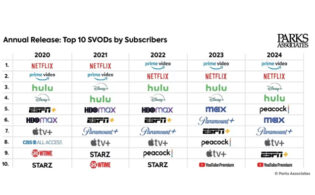Stay-at-home measures have been very good for SVOD platforms. According to Deloitte’s latest Digital Media Trends Survey, 23 percent of consumers added a streaming video service subscription since the start of the pandemic. And subscribers are now paying for an average of four services, up from three before COVID-19. Parks Associates found that 8 percent of U.S. broadband homes trialed four or more OTT services during the COVID-19 crisis. Between April 2019 and April 2020, the number of OTT homes in the U.S. rose by 5.2 million, according to Comscore’s 2020 State of OTT report.
“We are seeing a record number of consumers experiment with new OTT services as a result of the COVID-19 crisis and the shifts in strategy in the industry,” said Steve Nason, research director at Parks Associates. “OTT services are offering extended free trials to build up engagement, and 8 percent of U.S. broadband households report they have subscribed to at least one new OTT service since the COVID-19 crisis began.”
But with shutdown measures easing and consumers wary about troubling economic trends, some subscribers are starting to abandon their paid services. Per Deloitte, since the start of the global health crisis, 17 percent of subs canceled a paid service. And according to Parks Associates, the churn rate among OTT services in the U.S. rose from 35 percent in Q1 2019 to 41 percent in Q1 2020. Strategy Analytics issued a report recently indicating that usage numbers slipped for major SVOD platforms in the U.S.: 42 percent of respondents used Netflix in May, compared to 50 percent in April and 47 percent in March. Usage of Amazon Prime, Hulu and Disney+ followed a similar “pandemic peak” pattern. (This trend was not in place for all SVOD services though: the number of users of both Apple TV+ and CBS All Access rose in both April and May.)
“Ironically Netflix may have suffered through being the most popular SVOD service since it appears to have attracted many new but ultimately temporary users during the pandemic,” said Michael Goodman, Strategy Analytics’s director of TV and media strategies. “Its next quarterly results will be watched with interest in case its strong Q1 performance is not sustained into Q2. We still believe that Netflix numbers will exceed expectations overall during 2020, but now that the pandemic impact is waning, the company will face more traditional challenges associated with customer retention, win-back and targeting the right content to appropriate interests and demographics.”
High costs and expiring discounts or free trials have been cited as the top reasons for cancellation. “To win subscribers rapidly, many streaming video services are offering low introductory rates and free trials,” said Dr. Jeff Loucks, executive director at the Deloitte Center for Technology, Media and Telecommunications. “But with cheap trials and easy cancellations, consumers can binge-watch their favorite shows, drop the subscription, and then return when the next season launches. Since the COVID-19 pandemic began, streaming services have attracted more subscribers than ever. The biggest challenge for providers will likely be to retain customers once their series is over and the full price kicks in. Free ad-supported streaming could gain market share from paid services as budgets tighten.”
Deloitte found that 47 percent of U.S. consumers used at least one free AVOD service during COVID-19 as they sought “budget-friendly entertainment.” Per Deloitte, more U.S. consumers want access to cheaper, ad-supported streaming video options, both before (62 percent) and since the COVID-19 pandemic (65 percent), while 35 percent of consumers will pay to avoid ads. And according to Comscore, the growth in reach of ad-supported services is outpacing that of non-ad-supported services; ad-supported services grew by 9 percent between January 2020 and April 2020, while SVOD services were up 5 percent.
Platforms are also facing the challenge of keeping users engaged with new content as production remains stalled in the U.S. “The industry is working on new hybrid content strategies as a result of production halts,” according to Parks Associates’ Nason. “Major players like AT&T for Warner Bros. and Comcast for Universal Studios are greatly concerned about the delays in content production on the launches of new services, like HBO Max and Peacock. Free trials will bring in new subscribers at the launch, and roughly seven in ten have subscribed to at least one OTT service they have trialed. OTT services need to be creative in building an engaging service, but during this time of heavy video consumption, OTT services have the opportunity like never before to win over new video consumers and retain them as long-term subscribers.”
David Mercer, VP of media and intelligent home at Strategy Analytics, expressed a similar sentiment, noting that SVOD platforms “must all now focus on retaining customers who have joined recently as well as ensuring that their content development strategies are on track. This will prove challenging for many players, given the continuing crisis in video production as a result of COVID-19 restrictions.”






